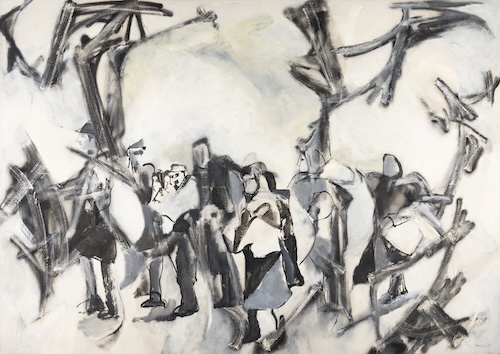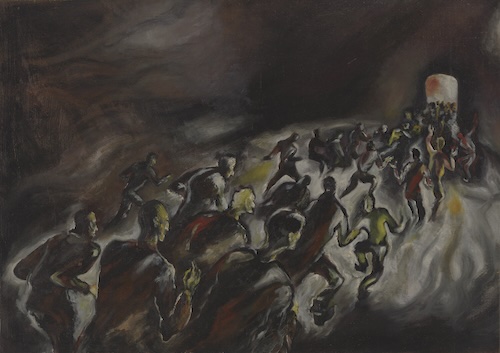Remembrance and Renewal: American Artists and the Holocaust, 1940–1970 is the first exhibition to examine the influence of the Holocaust on mid-twentieth-century American art. Curated by Eskenazi Museum of Art Curator of European and American Art Dr. Jennifer McComas, the exhibition will be on view from September 4 to December 14, 2025.
Seventy-four works of art (paintings, sculptures, drawings, prints, books, and studies for Holocaust memorials) will be presented courtesy of twenty-five lenders from across the United States, including the Museum of Modern Art, the Whitney Museum of American Art, and the National Gallery of Art. About one-third of the featured objects are from the Eskenazi Museum of Art’s permanent collection, and the project has served as a catalyst for several new acquisitions.
Artists represented in the exhibition range from canonical abstract painters such as Mark Rothko and Frank Stella to figures such as Abraham Rattner, Boris Lurie, Anna Walinska, and Luise Kaish, whose work deserves greater recognition. The aesthetic diversity of the exhibition illuminates the Holocaust’s broad—yet underrecognized—impact on midcentury American art.
According to Dr. McComas, "Only the most explicit representations of the Holocaust have been widely recognized. Many works in this exhibition instead allude to the Holocaust more obliquely through metaphor, symbolism, or simply through titles. Reading these works through the lens of Jewish text, ritual, and history reveals multiple layers of meaning and expands our understanding of the myriad ways artists have grappled with the Holocaust, especially in these early years when there was no precedent for visualizing an atrocity of this magnitude."
The exhibition is structured according to four themes, whose titles are presented in Hebrew and English. The first, Khurbn (Destruction), examines formal strategies and iconography used within the visualization of hatred, death, and annihilation. The theme of displacement and the experience of refugees is the central theme of the second section, Galut (Exile). The third section, Zakhor (Remember), analyzes how artists approached the Jewish imperative to memorialize the dead and their destroyed culture. Finally, Tikkun (Repair) presents artists’ visions of the renewal and rebirth of the Jewish people after an unprecedented catastrophe.
The exhibition is accompanied by a catalogue co-published by Yale University Press. It features essays by Dr. McComas; Samantha Baskind, Distinguished Professor of Art History at Cleveland State University; and Hasia Diner, Professor Emerita in the Department of History and the Skirball Department of Hebrew and Judaic Studies at New York University, and Director of the Goldstein-Goren Center for American Jewish History.
"I am proud to present this ground-breaking exhibition and catalogue, which celebrate the museum's dedication to research on under-recognized subjects in the history of art. I am grateful to Dr. McComas for leading this important project and recognize the many generous donors, lenders, and grantors for their support of Remembrance and Renewal," said Mariah Keller, Interim Director of the Eskenazi Museum of Art.
Considerations of Jewish artistic expression and experience have long been absent from standard art historical narratives. Remembrance and Renewal, while standing on its own as an effort to reconsider mid-twentieth-century American art from a Jewish perspective, also aligns with the Eskenazi Museum of Art’s Jewish Art Initiative, currently under development and led by Dr. McComas. The initiative aims to integrate Jewish art and culture into exhibitions and programming at the museum.
Support for Remembrance and Renewal has been provided by the Henry Luce Foundation; the Foltyn Family; the Dorit and Gerald Paul Fund for Jewish Culture and the Arts in the Borns Jewish Studies Program, Indiana University; Glick Philanthropies; the Herbert Simon Family Foundation; the IU Presidential Arts and Humanities Program; the Jewish Culture Center, Indiana University; the Memorial Foundation for Jewish Culture; the Boris Lurie Art Foundation and the Schaina & Josephina Lurje Memorial Foundation; Jack and Grace Dayan; POSH on Kirkwood, Elliot R. Lewis; Paula W. Sunderman, PhD; Dorit S. Paul; the Pressman Family; and faculty research funding from the Borns Jewish Studies Program, Indiana University.





